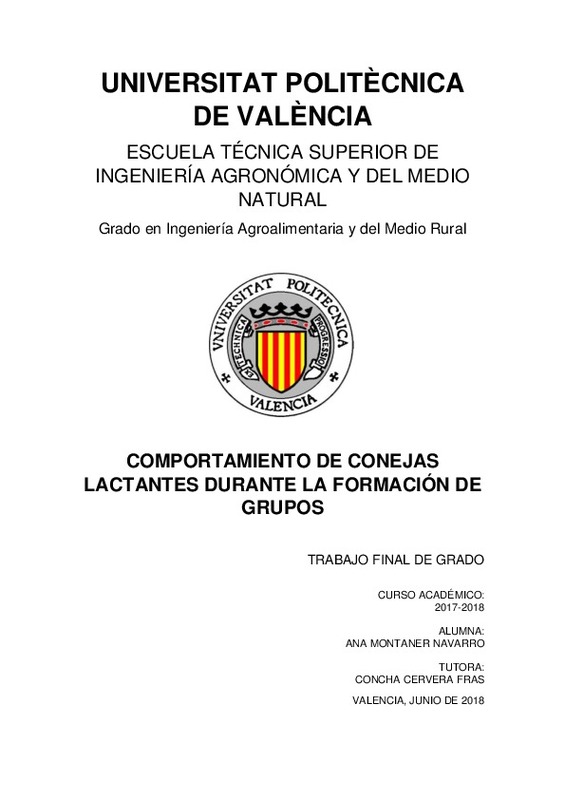|
Resumen:
|
[ES] En el presente trabajo se analizaron los diferentes comportamientos de las conejas
según el tipo de alojamiento empleado para su manejo, individual o grupal, con el
objetivo de averiguar qué modificaciones ...[+]
[ES] En el presente trabajo se analizaron los diferentes comportamientos de las conejas
según el tipo de alojamiento empleado para su manejo, individual o grupal, con el
objetivo de averiguar qué modificaciones comportamentales ocasiona el sistema de
alojamiento y cual es más beneficioso para el bienestar de las conejas, así como si
existe una habituación al manejo en régimen grupal.
Para el presente trabajo se emplearon 6 conejas. Las conejas estaban alojadas de forma
individual desde 3 días antes del parto hasta los 18 días post-parto cuando se les
reagrupó. Las jaulas contaban con nidales y plataforma. La jaula colectiva tenía una
superficie de 24000 cm2
(4000 cm2
/coneja). La alimentación de las conejas fue ad libitum
durante todo el experimento.
Los días anterior y posterior a los reagrupamientos se realizaron grabaciones de 24
horas. Las primeras grabaciones se realizaron cuando las conejas se encontraban en
su primer parto, y volvieron a realizarse otras cuando estaban en su tercer parto.
Se observó que el tipo de alojamiento influye en las conductas que realizan las conejas
y en su duración. En el alojamiento grupal se observó un aumento de los
desplazamientos respecto al alojamiento individual (184 s/h vs. 36 s/h), así como de los
contactos sociales pacífico (72 s/h vs. 7 s/h) y agresivo (8 s/h vs. 0,7 s/h) y las
fugas/refugios (210 s/h vs. 0 s/h). Mientras que en el alojamiento individual las conejas
destinaban más tiempo a comer (531 s/h vs. 403 s/h), a limpiarse (477 s/h vs. 274 s/h)
y a estar simplemente activas (857 s/h vs. 673 s/h).
Se ha observado que el número de parto de las conejas no influye en la duración de los
contactos sociales, ni maternales. Las conejas primíparas destinan más tiempo a
limpiarse, a realizar la cecotrofia y a estar activas, mientras que las que están en su
tercer parto pasan más tiempo descansando, comiendo y desplazándose.
Se observó que en el alojamiento individual existen diferencias entre las conejas
primíparas y las de tercer parto en referencia al tiempo destinado a limpiarse, a estar
activas e inactivas pero esas diferencias se reducen notablemente al reagruparlas.
El tiempo que destinan a fugarse o refugiarse es mayor en el alojamiento grupal, sobre
todo después del reagrupamiento, posiblemente debido a la necesidad de escapar de
los comportamientos agonísticos que comportan establecer una jerarquía social.
[-]
[EN] The different behaviours of rabbit does we analysed according to housing systems,
individual or group, with the aim of finding out behavioural changes are caused by the
housing system and which is more beneficial ...[+]
[EN] The different behaviours of rabbit does we analysed according to housing systems,
individual or group, with the aim of finding out behavioural changes are caused by the
housing system and which is more beneficial for the welfare of the rabbits, as well as if
there is an habituation to handling in a grouped regime.
In the present work six rabbit does were housed individually from 3 days before calving
to 18 days post-partum, when they were regrouped. The cages had nests and
platforms. The collective cage had an area of 24000 cm2
(4000 cm2
/doe). The rabbit
does were fed ad libitum through all the experiment.
Two 24 hours video records were made before and after the regroupings at first and
third lactations.
The housing system influences the behaviours of the rabbit does and their duration. In
the group-housing there was an increase in locomotion compared to single (184 s/h vs.
36 s/h), as well as peaceful social contacts (72 s/h vs. 7 s/h), aggressive behaviour (8
s/h vs. 0.7 s/h) and leaks/refuges (210 s/h vs. 0 s/h). While in the individual housing
the rabbit does spent more time eating (531 s/h vs. 403 s/h), grooming (477 s/h vs. 274
s/h) and active (857 s/h vs. 673 s/h).
The number of calving doesn’t influence the duration of social or maternal contacts.
Primiparous rabbit does spend more time grooming, eating cecotrophes and being
active, while those in their third birth spend more time resting, eating and moving.
There are differences between the primiparous and third calving rabbit does in
reference to the time destined to grooming, to be active and inactive in single housing,
but these differences are significantly reduced when they are regrouped.
The time spent to escape or take refuge is greater in the group-house system,
especially just after regrouping, possibly due to the need to escape the agonistic
behaviour that involves establishing a social hierarchy.
[-]
|






